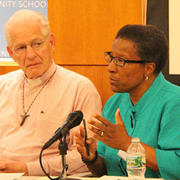
For Mary Setterholm, MDiv '13, her lived experience with sexual and gender-based violence motivates and informs her ministry.
Setterholm is currently a pastoral activist with Serenity Sisters, and she was one of four faith leaders who participated in a recent panel discussion at HDS on the role of the faith leader in addressing sexual and gender-based violence (SGBV).
Other panelists included the Rev. Jedediah Mannis, MDiv '04 and founder and minister of Outdoor Church in Cambridge, and Cheryl Giles, Francis Greenwood Peabody Senior Lecturer on Pastoral Care and Counseling at HDS.
HDS professor Ahmed Ragab and Richard Santos, MTS '92 and executive director of IMA World Health, moderated the panel and started the conversation by presenting data published in the Sojourners and IMA World Health study "Broken Silence: A Call for Churches to Speak Out," which polled 1,000 protestant pastors on how they understand sex and gender-based violence.
"The fact that 65 percent of pastors spoke about SGBV in their congregations less than once a year really told me that the issue is not a core message within the church." Santos said. "Another big discovery was that not only were a number of pastors unaware of local resources, but also, when asked they gave the wrong advice."
While this research may have been surprising to members of the audience, the panelists seemed to agree that the data presented matched their expectations.
"I was really impressed with this study because it tells the truth," said Setterholm.
Panelists agreed that there is a popular tendency to see SGBV as a problem somewhere else rather than in our own communities and congregations.
Recently, news stories like the video of former Baltimore Ravens running back Ray Rice striking his fiancée in an elevator, or the continued outcries on college campuses about the mismanagement of sexual assault cases, have brought the issue home.
In his work ministering to homeless people in Cambridge, Mannis says the most effective way to introduce the public to the reality of SGBV is to have them see it for themselves.
"A lot of churches support us by coming out with us on Sundays—groups of children, adults, and parents," Mannis said. "When they see for the first time what it looks like, it's a shock. People go back to their churches and take with them an understanding that they didn't have before."
Mannis and Giles were both concerned with populations that are particularly vulnerable to SGBV, including homeless teens, GLBT youth, and college freshmen. Often, these young men and women are living independently for the first time and are reluctant to ask adults for help.
Giles also argued that it should be a requirement for clergy to engage in continued education on the topic of SGBV so that they will be informed in the ministry to those experiencing SGBV.
She added that faith leaders "can offer encouragement to victims that this is not a time to be independent—this is a time to reach out."
Ragab asked: "What is the overall environment that would add support for victims and survivors?"
The panelists agreed that continuing research on the social and institutional conditions that facilitate and permit silence on the issue of SGBV will be a crucial element in implementing meaningful social change.
Setterholm said that this can begin by reassessing the words used to describe men and women who experience SGBV.
“Calling someone a victim suggests that they have been defeated, and calling someone a survivor implies that the trauma is over," she explained. "I prefer veteran. Veterans have a narrative of resilience and tenacity. Veterans can hold their heads up high."
—by Erica Long
